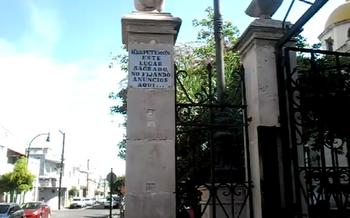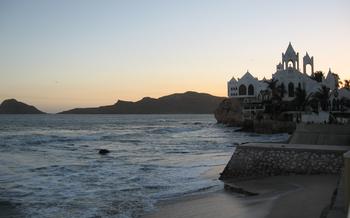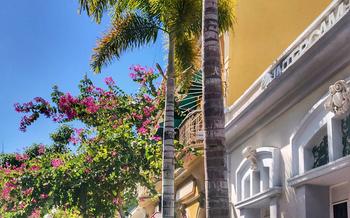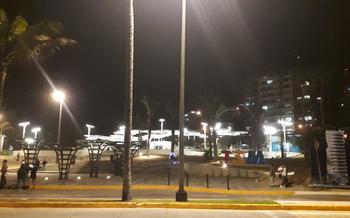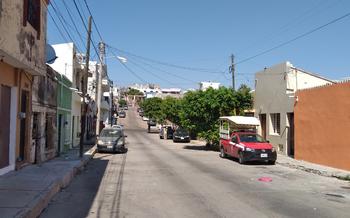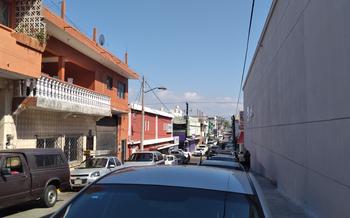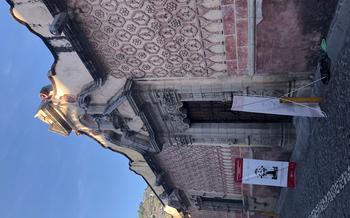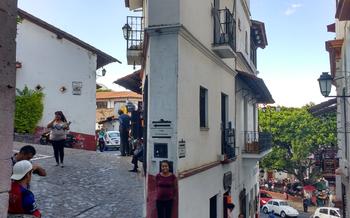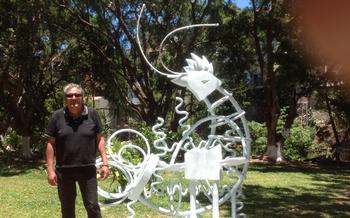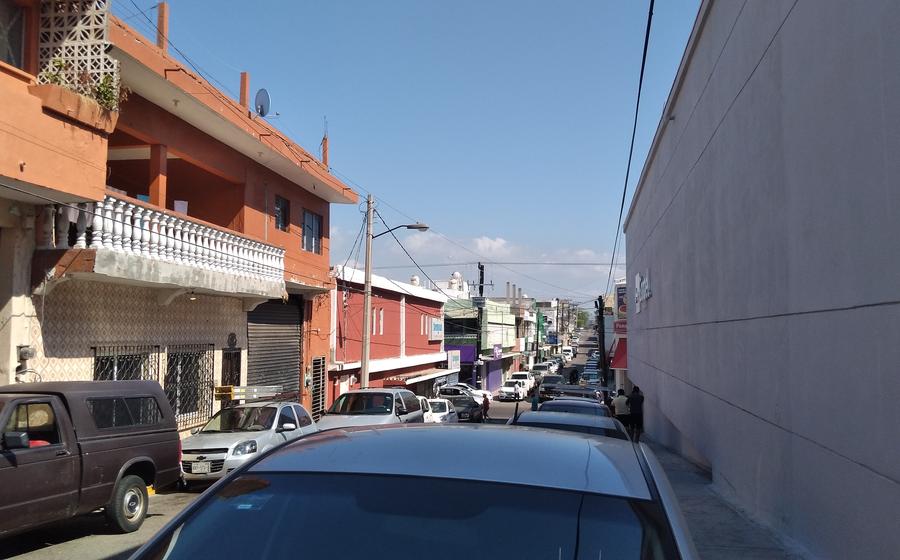
Old Spanish Fort
- A Mazatlán Landmark
- The History of the Fortress
- The Construction of the Fortress
- The Fortress Through the Years
- Exploring the Fortress
- The Fortress Museum
- The Fortress as a Cultural Venue
- The Fortress and the Community
- Tips for Visiting the Fortress
- The Fortress in Popular Culture
- The Fortress and Tourism
- The Future of the Fortress
- The Fortress and Social Media
- Interesting Facts and Trivia
- Insider Tip: Unveiling Hidden Treasures
A Mazatlán Landmark
In the heart of Mazatlán's historic district, El Viejo Fuerte San Carlos stands as a testament to the city's rich history and resilience. Built in the late 18th century, this formidable fortress played a crucial role in safeguarding the city from invading forces and pirate attacks. Its strategic location, commanding views of the Pacific Ocean and the surrounding mountains, made it an indispensable defensive structure for over two centuries.
Historical Importance Constructed during the colonial era, the fortress served as a vital military outpost for the Spanish Empire. It was part of a network of fortifications designed to protect the Pacific coast from marauding pirates and privateers who preyed on Spanish ships carrying precious cargo. The fortress's imposing presence effectively deterred attacks, ensuring the safety of seafaring trade and the prosperity of Mazatlán.
Strategic Location Perched on a hill overlooking the city and the ocean, El Viejo Fuerte San Carlos was meticulously positioned to provide maximum protection. Its elevated location offered unobstructed views of the surrounding landscape, allowing the garrison to spot approaching vessels well in advance. This strategic advantage enabled the fortress to repel numerous attacks and maintain control of the region.
Current Uses Today, the fortress stands as a symbol of Mazatlán's enduring spirit and rich cultural heritage. No longer serving its original military purpose, it has been transformed into a captivating museum and cultural center. Visitors can explore the fortress's well-preserved ramparts, dungeons, and courtyards, while learning about its fascinating history and significance.
The History of the Fortress
Mazatlán's Old Spanish Fort is a testament to the city's rich and tumultuous history. Its story begins in the 16th century, when Spanish conquistadors arrived in the region and established a settlement. As the settlement grew and prospered, it became a target for pirates and privateers who preyed on the Spanish galleons laden with New World treasures.
In response to these threats, the Spanish authorities decided to construct a fortress to protect the city and its inhabitants. The fortress was built in the 17th century, during the colonial period of Mexico. It was designed in the style of a Spanish fort, with thick walls, turrets, and a moat. The fortress was armed with cannons and manned by a garrison of soldiers, who were responsible for defending the city against attack.
The Construction of the Fortress
The construction of the fortress was a remarkable feat of engineering and resilience, showcasing the determination of the Spanish colonizers to protect their interests in the region. Skilled craftsmen and laborers worked tirelessly to create a formidable structure capable of withstanding attacks from both sea and land.
The fortress was built using locally sourced materials, including stone, brick, and mortar. The thick walls, which can reach up to 6 meters (20 feet) in thickness, provided sturdy protection against enemy fire. The fortress's strategic location on a hilltop allowed for commanding views of the surrounding area, enabling the defenders to spot approaching threats from a distance.
The fortress's defensive features were meticulously designed to deter and repel attacks. The entrance was reinforced with a drawbridge and a portcullis, while the ramparts were equipped with cannons and gunports, providing the defenders with a powerful arsenal to defend their positions.
The construction of the fortress faced several challenges, including the rugged terrain and the harsh climate. The builders had to overcome logistical difficulties in transporting materials and supplies to the site. The construction also required significant financial resources, which were provided by the Spanish crown.
Despite the challenges, the fortress was completed in the early 17th century, serving as a testament to the ingenuity and perseverance of its builders. It stands as a symbol of Mazatlán's rich history and its enduring legacy as a fortified city.
The Fortress Through the Years
Over the centuries, the fortress played a crucial role in Mazatlán's history. In the 19th century, it served as a defensive stronghold during various conflicts, including the Mexican-American War and the Reform War. During the French Intervention in the 1860s, the fortress was a vital strategic position for the Mexican forces resisting the French occupation.
In the early 20th century, the fortress underwent significant modifications and adaptations to accommodate changing military needs. It was equipped with modern artillery and defensive systems, transforming it into a formidable fortification. Despite its military significance, the fortress gradually transitioned into a cultural and historical landmark in the latter half of the 20th century.
The fortress's cultural significance stems from its role in preserving and showcasing Mazatlán's rich history. It now houses a museum dedicated to the city's past, featuring exhibits on the fortress's construction, history, and military significance. The fortress also serves as a venue for cultural events, such as art exhibitions, musical performances, and theatrical productions, further enhancing its status as a vibrant cultural hub in Mazatlán.
Exploring the Fortress
Entering the fortress, visitors are greeted by a majestic main entrance that hints at the grandeur within. The central courtyard, with its intricate stonework and arched walkways, provides a glimpse into the fortress's colonial past. Here, visitors can admire the well-preserved cannons that once defended the city from invaders. Ascending the ramparts, visitors are rewarded with breathtaking panoramic views of Mazatlán's cityscape, the sparkling ocean, and the verdant mountains in the distance. These vantage points offer a unique perspective on the city and its surroundings, making them popular spots for photography and relaxation.
The Fortress Museum
The Old Spanish Fort in Mazatlán is home to a fascinating museum that offers visitors a glimpse into the history and significance of the fortress. The museum's exhibits and displays are thoughtfully curated, featuring historical artifacts, interactive elements, and educational panels that bring the fortress's past to life.
Visitors can explore exhibits on the construction and military history of the fortress, as well as its role in defending Mazatlán from foreign invaders. The museum also showcases artifacts from the colonial period, including weapons, uniforms, and everyday objects that provide a deeper understanding of life in Mazatlán during that era.
Interactive elements, such as touch screens and augmented reality displays, engage visitors and allow them to experience the fortress's history in a dynamic and interactive way. The museum's educational value is further enhanced by guided tours led by knowledgeable historians who provide insights and anecdotes that bring the fortress's story to life.
The Fortress as a Cultural Venue
The Old Spanish Fort in Mazatlán has evolved into a vibrant cultural hub, hosting a diverse range of events that showcase the city's rich heritage and artistic expression. The fortress's unique ambiance and historical charm provide an exceptional backdrop for cultural performances and exhibitions.
Art enthusiasts can immerse themselves in captivating exhibitions that showcase the works of local and international artists. The fortress's galleries and exhibition spaces offer a platform for emerging and established artists to display their creations, promoting cultural exchange and fostering appreciation for the arts.
The fortress also reverberates with the sounds of music, hosting intimate concerts and grand musical performances. From traditional Mexican melodies to contemporary international beats, the fortress's acoustics create an immersive experience for music lovers.
Theatrical productions take on a new dimension within the fortress's walls. The historical setting lends itself perfectly to historical dramas, comedies, and contemporary plays, transporting audiences to different eras and captivating them with powerful performances.
Special events, such as festivals, cultural fairs, and historical reenactments, bring the fortress to life, immersing visitors in the vibrant traditions and customs of Mazatlán. These events celebrate the city's rich heritage and offer a glimpse into its colorful past.
The fortress's transformation into a cultural venue has solidified its position as a cornerstone of Mazatlán's cultural landscape. It has become a place where history, art, and performance converge, creating unforgettable experiences for visitors and locals alike.
The Fortress and the Community
The Old Spanish Fort holds a special place in the hearts of Mazatlán's community. It is a symbol of their heritage, a source of local pride, and an important part of the city's identity. The fortress has played a vital role in shaping the community's history and culture, and it continues to be an important part of local life today.
The fort is a popular destination for educational programs and community events. School groups often visit the fortress to learn about its history and significance, and local organizations host a variety of events within its walls, including art exhibitions, musical performances, and theatrical productions. These events help to promote cultural appreciation and foster a sense of community pride.
The fortress has also become a symbol of Mazatlán's resilience and determination. Despite facing numerous challenges over the years, the fortress has stood strong, serving as a reminder of the city's ability to overcome adversity. It is a testament to the strength and spirit of the Mazatlán community.
Tips for Visiting the Fortress
To make the most of your visit to the Old Spanish Fort, consider the following tips:
-
Best time to visit: The fortress is open year-round, but the best time to visit is during the shoulder seasons (May-June and September-October) when the weather is pleasant, and the crowds are smaller.
-
Guided tours: Guided tours are available in English and Spanish and offer a deeper insight into the history and significance of the fortress. Tours typically last for about an hour and are led by knowledgeable guides who can answer your questions.
-
Accessibility considerations: The fortress is accessible to visitors with disabilities, with ramps and elevators providing access to all levels. Wheelchair rentals are also available upon request.
-
Photography opportunities: The fortress offers stunning views of the city and the surrounding mountains, making it a great spot for photography. Be sure to bring your camera to capture the beauty of this historic landmark.
The Fortress in Popular Culture
The Old Spanish Fort in Mazatlán has captured the imagination of artists, writers, and filmmakers alike, becoming a prominent feature in popular culture. The fortress has served as a backdrop for numerous movies and television shows, including the popular Mexican telenovela "Corazón Salvaje" and the American action-adventure film "Romancing the Stone." Its distinctive architecture and historical significance have also inspired works of literature and art, with local legends and folklore adding to its mystique. The fortress's international recognition has further cemented its place in popular culture, attracting visitors from around the world who come to experience its unique charm and rich history.
The Fortress and Tourism
The Old Spanish Fort is a major tourist attraction in Mazatlán, drawing visitors from around the world. The fortress's historical significance, architectural beauty, and panoramic views make it a popular destination for travelers interested in history, culture, and photography.
The fortress's transformation into a cultural and historical landmark has had a significant economic impact on Mazatlán. The fort attracts thousands of visitors each year, generating revenue for local businesses and contributing to the city's economy. It has also helped to promote Mazatlán's history and culture, showcasing the city's rich heritage to a global audience.
The fort's status as a cultural and historical landmark has contributed to the development of sustainable tourism practices in Mazatlán. The city has taken steps to ensure that the fort is preserved for future generations while also providing visitors with a memorable and educational experience. This includes implementing measures to reduce the environmental impact of tourism, such as waste management and energy conservation practices.
The Future of the Fortress
The Old Spanish Fort stands as a testament to Mazatlán's rich history and cultural heritage. Its preservation and continued use are of utmost importance to the community. Ongoing efforts are underway to ensure that the fortress remains a vibrant and relevant part of Mazatlan's cultural landscape.
Preservation efforts focus on maintaining the fortress's structural integrity and restoring its original features. Regular maintenance and restoration work help to safeguard the fortress from the elements and ensure its longevity. The fortress's unique architectural style and historical significance make it a valuable asset to the city, and its preservation is essential for future generations to appreciate and enjoy.
Plans for further development of the fortress include expanding its role as a cultural venue and creating new spaces for exhibitions, performances, and educational programs. Adaptive reuse initiatives are also being considered, such as converting parts of the fortress into boutique hotels or restaurants while preserving its historical character.
Ensuring the fortress's legacy involves promoting its historical and cultural significance to both local and international visitors. Educational programs, guided tours, and interactive exhibits help to raise awareness of the fortress's importance and foster a sense of appreciation for Mazatlán's heritage.
By combining preservation efforts, adaptive reuse initiatives, and community engagement, the Old Spanish Fort will continue to thrive as a symbol of Mazatlán's rich history and cultural identity for years to come.
The Fortress and Social Media
In the digital age, the Old Spanish Fort has embraced social media as a powerful tool to connect with visitors and followers from around the world. Through its active presence on platforms like Facebook, Instagram, and Twitter, the fortress shares captivating stories, historical insights, and stunning visuals that bring its rich heritage to life. Virtual tours and interactive experiences allow people to explore the fortress's nooks and crannies from the comfort of their homes. Social media campaigns and hashtags encourage engagement and foster a sense of community among those passionate about the fortress's preservation and promotion. By leveraging the power of social media, the Old Spanish Fort extends its reach, raises awareness, and invites people to discover the wonders of this iconic landmark.
Interesting Facts and Trivia
- The fortress's thick walls are said to be home to a network of secret tunnels and chambers, some of which have yet to be fully explored.
- During the French Intervention, the fortress was briefly occupied by French forces who left behind graffiti and markings on the walls, some of which can still be seen today.
- In the 1960s, a group of local divers discovered a sunken treasure ship just off the coast of the fortress, believed to have been carrying gold and jewels from a Spanish galleon that sank during a storm in the 16th century.
- The fortress is said to be haunted by the ghosts of soldiers and sailors who lost their lives defending it over the centuries. Visitors have reported seeing strange lights, hearing disembodied voices, and feeling a cold chill in the air, especially at night.
- In 2010, the fortress was featured in a popular Mexican telenovela, which helped to raise its profile and attract even more visitors.
Insider Tip: Unveiling Hidden Treasures
Delve deeper into the fortress's allure with these insider tips:
-
Secret Viewpoints: Discover secluded spots offering breathtaking vistas of the ocean, the city, and the surrounding mountains. Capture panoramic shots that will leave your followers in awe.
-
Hidden Gems: Explore the fortress's lesser-known nooks and crannies. Uncover hidden chambers, secret passageways, and charming courtyards that reveal the fortress's rich history.
-
Off-the-Beaten-Path Experiences: Embrace the road less traveled. Venture beyond the main tourist areas to find serene corners where you can soak in the fortress's tranquility and capture unique perspectives.
-
Local Recommendations: Indulge in Mazatlán's culinary delights at local eateries favored by the locals. Discover authentic flavors and hidden gems that will tantalize your taste buds. Explore the city's vibrant markets for souvenirs and handicrafts that reflect the region's rich cultural heritage.
Remember, the true essence of the fortress lies in its ability to transport you back in time. Embrace the opportunity to immerse yourself in its captivating history, stunning architecture, and breathtaking views. Share your experiences with the world, but always respect the fortress's sacred legacy.
